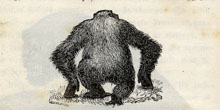New myths

The Darwin Industry proved a series of myths to be wrong. However, new ones arose in the wake of the social and cultural studies of Darwin. One that has proven difficult to refute relates to the 21 years that passed from the time Darwin formulated his theory in 1837 until he published it in 1858 (the year before the publication of On the Origin of Species). A widespread story written as a direct rebellion against the sanitary scientific Darwin proclaims that Darwin quite simply was afraid of publishing his theory. He knew it to be true but dangerous and would be conceived as revolutionary as well as detrimental to the present societal form. It made him physically ill to live with this unbearable secret and reluctantly, he was finally forced to publish it due to the circumstances.
More recent studies have shown that quite a lot of people knew about Darwin’s ideas before he published them. It was not a top secret theory. It had not been completed and Darwin was occupied by a series of other projects. He was a busy man.
Another result of the intensive studies of Darwin’s correspondence has been that particularly captivating passages have been taken out of their context, interpreted, and quoted endlessly. One example is where Darwin wrote his good friend Joseph Hooker that he felt that publishing his theory would be equal to him “confessing a murder”. This short remark has been interpreted to show how awful Darwin felt about the publication of the theory and how important it was for him that it remained secret. Once again, this was interpreted as evidence that Darwin’s theory made him ill.
However, the truth is that Darwin wrote this to Hooker as a humorous remark. Darwin’s letters were full of these types of phrases about everyday events. There is no reason to jump to rash, dramatic, and incorrect conclusions based on this.
Also, it has been repeated time and time again that Darwin was only present on the voyage of the HMS Beagle as a companion to the captain; that Darwin’s function was of a social nature and that he had no obligations or any official significance with regards to the voyage. Many historians have used this as documentation to downplay the importance of Darwin’s participation on the voyage from a contemporary point of view. It has been argued that subsequent to Darwin becoming a scientific icon, he has been ascribed a greater significant role than was actually the case.
It has had the positive effect of counteracting the myth that the Beagle voyage was Darwin’s expedition. It was not. However, it was also not the case that Darwin’s function on the voyage was merely a social one. In several of the official documents he was listed as the natural historian i.e. a resident scientific expert and in that connection had concrete assignments relating to natural history.
Finally, there has been a widespread theory that Darwin lost his religious faith following the early death of his daughter Annie. This story has been repeated endlessly even in serious works. However, this myth has no validity and can in no way be documented.
The positive message in these examples is that although a substantial amount of material has been written on Darwin, his letters and notebooks have been thoroughly studied by the world’s leading experts, and well, there is still a lot that has yet to be revealed.
Peter C. Kjærgaard









